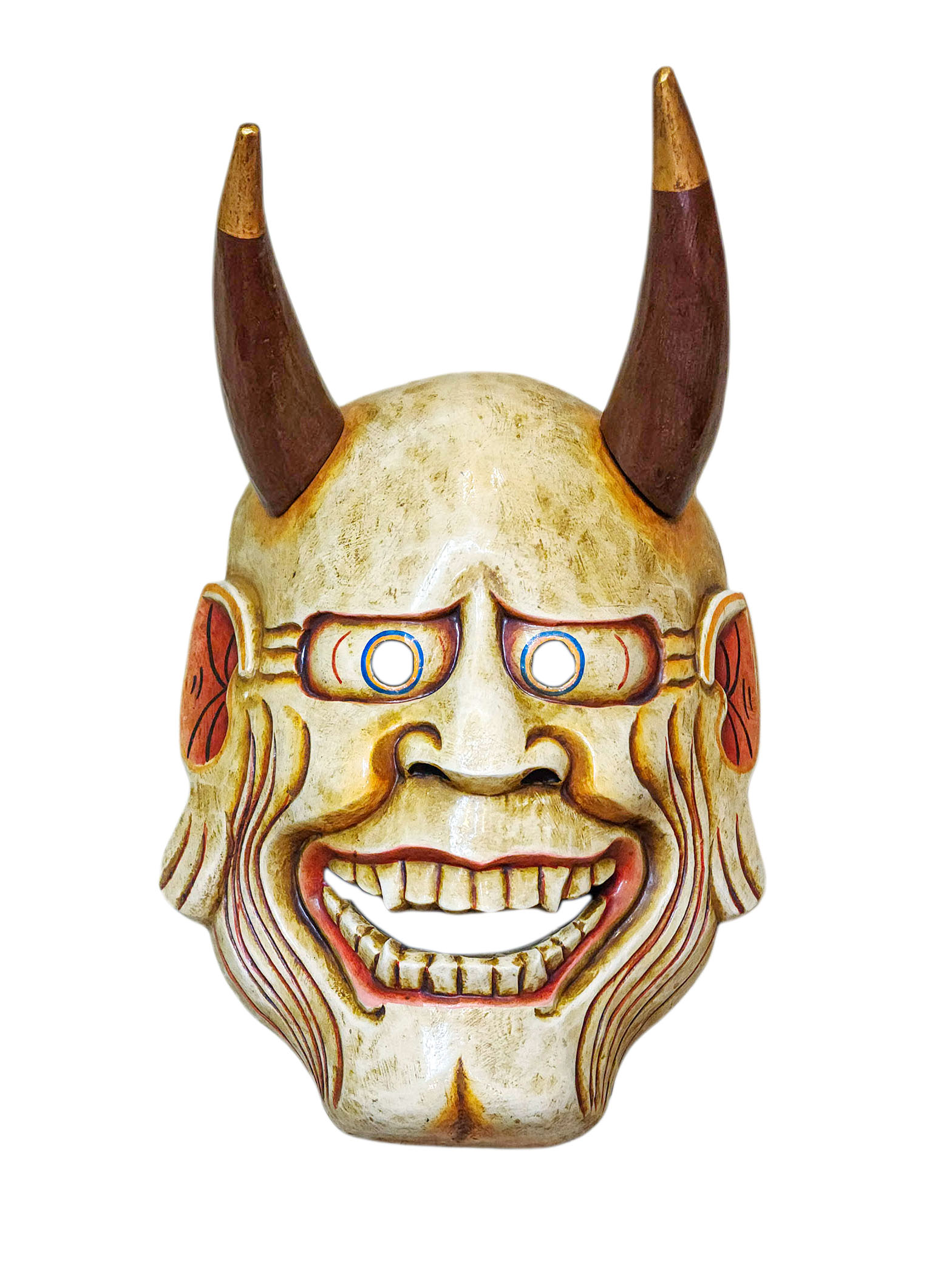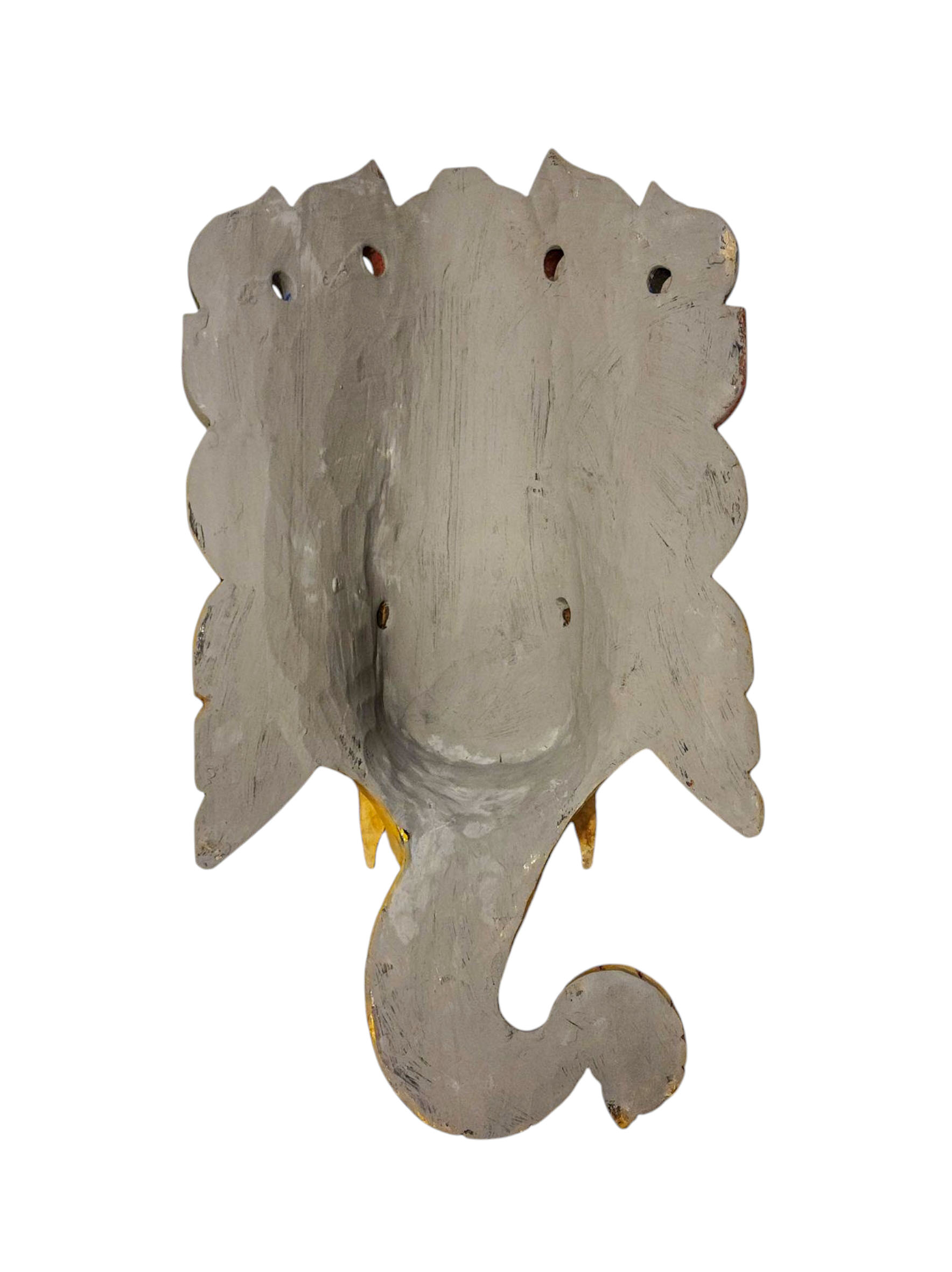Code
HCS35146
Weight
1.4 Kg / 3.09 lbs
Size
Height
43cm (17") Width
32cm (13") Depth
27cm (11") Material
Wood
Availability
Available

Safe Payment
We accept Paypal, Money Transfer, Bank Transfer
Confidence
Protection covers your purchase and personal data.
Worldwide Delivery
We ship Worldwide, except Russia.Shipping cost US$25.2 for upto 0.5 kgs

Hotline
Talk to help line for your question on 9841267335About Color Finishing
The Buddhist Wooden Tribal Mask With [oni], Tibetan Style With Traditional Colors is adorned with traditional colors, creating a captivating aesthetic through a combination of gold and various hues. This painting technique follows a time-honored process that aims to faithfully represent the Buddhist Wooden Tribal Mask With [oni], Tibetan Style With Traditional Colors in accordance with traditional color descriptions. In the context of Buddhist statues, this approach holds great significance. Each statue has its own primary color, and it is crucial to depict the statue in its authentic shade. Read More . . .
The Buddhist Wooden Tribal Mask With [oni], Tibetan Style With Traditional Colors is adorned with traditional colors, creating a captivating aesthetic through a combination of gold and various hues. This painting technique follows a time-honored process that aims to faithfully represent the Buddhist Wooden Tribal Mask With [oni], Tibetan Style With Traditional Colors in accordance with traditional color descriptions. In the context of Buddhist statues, this approach holds great significance. Each statue has its own primary color, and it is crucial to depict the statue in its authentic shade. Read More . . .
Brief Introduction :
The Oni is a type of demon or ogre from Japanese folklore, often depicted as a fearsome creature with horns, sharp claws, and tusks. Oni are commonly portrayed with bright-colored skinâred, blue, or greenâand usually wear tiger-skin loincloths and carry large iron clubs, known as kanabo. These devils are a representation of malevolent forces, embodying evil, destruction, and punishment, but they can also serve as protectors in some contexts.
Oni are often featured in Japanese mythology as creatures that torment humans, cause disasters, or act as enforcers of hellâs punishments. In many tales, they devour humans or spirits, and their appearance is meant to inspire terror. However, in certain Buddhist traditions, Oni are also seen as guardians or protectors of sacred places, keeping out evil forces.
The portrayal of Oni varies in different storiesâsome can be purely malicious, while others have a more complex role, acting as both punisher and protector, reminding people of the balance between good and evil.
Oni are also central to Japanese festivals such as Setsubun, where people throw beans at an Oni mask or effigy to symbolically drive away bad luck and evil spirits. The Oni has become a lasting symbol in Japanese culture, representing the boundary between chaos and order, good and evil.
The portrayal of Oni varies in different storiesâsome can be purely malicious, while others have a more complex role, acting as both punisher and protector, reminding people of the balance between good and evil.
Oni are also central to Japanese festivals such as Setsubun, where people throw beans at an Oni mask or effigy to symbolically drive away bad luck and evil spirits. The Oni has become a lasting symbol in Japanese culture, representing the boundary between chaos and order, good and evil.


![Buddhist Wooden Tribal Mask With [oni], Tibetan Style With Traditional Colors](https://handmadeexpo.com/pics/product/thumb/35146.jpg)
![Buddhist Wooden Tribal Mask With [oni], Tibetan Style With Traditional Colors](https://www.handmadeexpo.com/pics/product/thumb/35146_0.jpg)
![Buddhist Wooden Tribal Mask With [oni], Tibetan Style With Traditional Colors](https://www.handmadeexpo.com/pics/product/thumb/35146_1.jpg)
![Buddhist Wooden Tribal Mask With [oni], Tibetan Style With Traditional Colors](https://www.handmadeexpo.com/pics/product/thumb/35146_2.jpg)
![Buddhist Wooden Tribal Mask With [oni], Tibetan Style With Traditional Colors](https://www.handmadeexpo.com/pics/product/thumb/35146_3.jpg)

 Bhairav, Handmade Wooden Mask, Wall Hanging,
Bhairav, Handmade Wooden Mask, Wall Hanging,  Bhairav, Handmade Wooden Mask, Wall Hanging,
Bhairav, Handmade Wooden Mask, Wall Hanging,  Bhairav, Handmade Wooden Mask, Wall Hanging, Painted, Poplar Wood" title="
Bhairav, Handmade Wooden Mask, Wall Hanging, Painted, Poplar Wood" title=" Bhairav, Handmade Wooden Mask, Wall Hanging, Painted, Poplar Wood" title="
Bhairav, Handmade Wooden Mask, Wall Hanging, Painted, Poplar Wood" title=" Long Face, Handmade Wooden Mask,
Long Face, Handmade Wooden Mask,  Long Face, Handmade Wooden Mask,
Long Face, Handmade Wooden Mask,  Painted Yellow, Poplar Wood" title="Mahakala Mask, Handmade Wooden Mini Mask,
Painted Yellow, Poplar Wood" title="Mahakala Mask, Handmade Wooden Mini Mask,  Painted Yellow, Poplar Wood" title="Mahakala Mask, Handmade Wooden Mini Mask,
Painted Yellow, Poplar Wood" title="Mahakala Mask, Handmade Wooden Mini Mask,  Bhairab, Handmade Wooden Mask, Wall Hanging,
Bhairab, Handmade Wooden Mask, Wall Hanging,  Bhairab, Handmade Wooden Mask, Wall Hanging,
Bhairab, Handmade Wooden Mask, Wall Hanging,  Ganesh, Handmade Wooden Mask, Wall Hanging,
Ganesh, Handmade Wooden Mask, Wall Hanging,  Ganesh, Handmade Wooden Mask, Wall Hanging,
Ganesh, Handmade Wooden Mask, Wall Hanging,  with Stone Setting, Poplar Wood" title="Woodenganesh Mask
with Stone Setting, Poplar Wood" title="Woodenganesh Mask  with Stone Setting, Poplar Wood" title="Woodenganesh Mask
with Stone Setting, Poplar Wood" title="Woodenganesh Mask  Bhairav, Handmade Wooden Mask, Wall Hanging, Painted, Poplar Wood" title="
Bhairav, Handmade Wooden Mask, Wall Hanging, Painted, Poplar Wood" title=" Bhairav, Handmade Wooden Mask, Wall Hanging, Painted, Poplar Wood" title="
Bhairav, Handmade Wooden Mask, Wall Hanging, Painted, Poplar Wood" title=" Lakhe, Handmade Wooden Mask, Wall Hanging,
Lakhe, Handmade Wooden Mask, Wall Hanging,  Lakhe, Handmade Wooden Mask, Wall Hanging,
Lakhe, Handmade Wooden Mask, Wall Hanging,  of Ganesh,
of Ganesh,  of Ganesh,
of Ganesh,